Historical paintings featuring flying machines
The very first historical paintings featuring flying machines driven by men dated back the 18th century, thus in accordance with the early age of aerostation. By the Great War, aviation became a recurrent subject mainly for advertising purpose. Shortly before World War II, the first generation of specialized artists devoted to aviation arouse in both Great Britain and the United States of America. Ever since, paintworks related to aviation have evolved, and even if confined to a minority, these have their own space, painters associations, collectors devoted to aircraft, art galleries, exhibitions and contests.
BOOTLED DRAGONFLY
Oil on canvas, 36 x 43-cm.
The operational lifetime of this Hugues 269ª in Spain dates back from 1963. It was bought by the Compañía General de Helicópteros S.A. (General Company Of Helicopters) and given the license plate EC-AVI (c/n 43-0201). Later, this helicopter was serving in TAF (Trabajos Aéreos y Fotogramétricos S.A. Air And Photo-grametrical Work), and was mainly entrusted air advertising tasks, steadily flying over Barcelona and some other Catalan cities. This company also operated with another H269A whose license plate was EC-AUR.

I have found photographs showing advertising of both the textile firm Tergal and the newspaper La Vanguardia. As time goes by, this EC-AVI was owned by SEGASA (Servicios Generales Aéreos S.A. General Air Services) and by Real Aeroclub de Barcelona-Sabadell, and was lost in 1998 in an accident. A while ago, in the website, I found by chance two pictures showing this EC-AVI. Both B/W photographs were so really beautiful that I was tempted by its much original features with the Cacao Ram’s bottle (milk and cocoa) shaped and painted on wood or aluminium plate and then attached to both sides of the helicopter through a tubular structure. I tried by all means to find out the original painting scheme but, unfortunately I couldn’t collect any useful information.
Time after, I discovered a much telling colour picture in a blog by Javier Ortega Figueiral. This photo was included in an interesting and thoroughly documented article about the story of air advertising in Spain. We can also recommend some beautiful pictures of the EC-AUR found in the historical archives of the website.
As far as this outstanding helicopter is concerned, I must confess that during both the drawing and the painting processes, its structural complexity and its wealth of detail tested my patience.
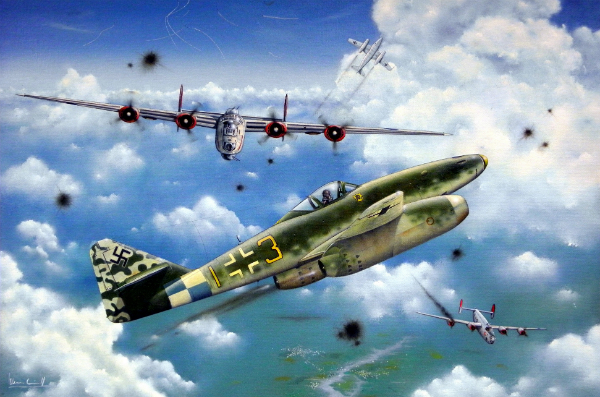
TOTENKOPF
Oil on canvas, 35×52 cm.
The idea for this painting, made a few years ago, was the reading of a vivid story on the German jag units entrusted the Defence of the Reich and the desperate attempts to stop the Allied bombing offensive, early in 1945, in lack of both material and experienced pilots.
The pictures taken during this period showed a large number of casualties on both sides exposing that the air combats were close and fierce.
As far as the painting is concerned, I used the rule of the “Golden Number” to sort all the elements present in this composition; the calculations to get the necessary axles’ framework are so really simple. Using this rule, knowing its basis, we can work in the right proportion and correctly distribute the space, although it is also possible to forget it and to work more intuitively and freely. The “Golden Section” allows understanding the works of some other painters, particularly the artwork by the old masters.
RED COMET
Oil on canvas, 36×43 cm.
With its features, so pure and elegant, the De Havilland DH.88 Comet is beautiful no matter the point of view. Along with the prototype three standard units were built to enter the 1934 McRobertson air race from England to Australia, the winner was the aircraft with the G-ACSS license plate named Grosvenor House.
It is easy to find good photos of this one in different aviation websites as it has been perfectly restored and is still in duty.
As far as the painting scheme is concerned I got different red shades using permanent madder deep, transparent red and cadmium yellow, always adding a bit of ultramarine deep to match the colour of the background. All those paints dry very slowly so I also mixed an accelerant medium, more particularly Liquin from Winsor & Newton’s range. This product has become irreplaceable in my studio as it improves the shining, allows carrying out smooth blurring effects and does not turn yellow.
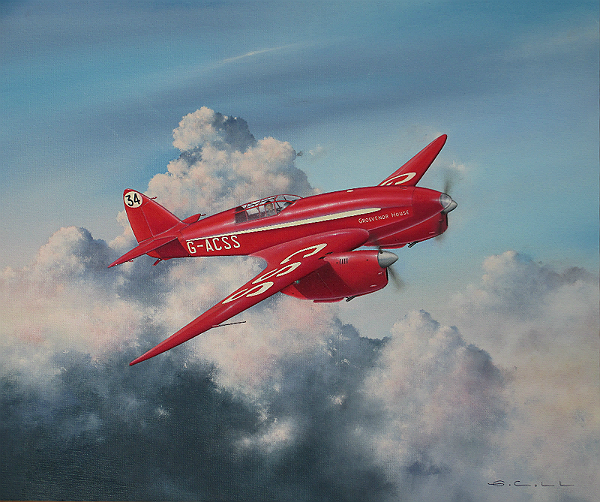
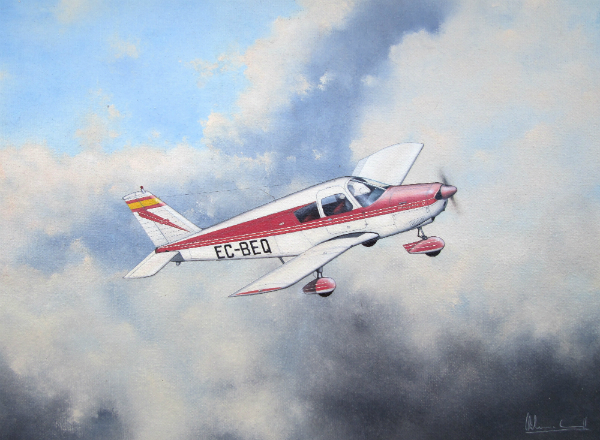
PIPER PA-28-180 Cherokee C
Oil on canvas 25×34 cm.
A few years ago I started a series of series of pictures related to light classical aircraft which have flown in Spain. My very early enquiries required to have a list of plates in order to know all models that had flown in Spain for me to be capable of choosing the best ones according to originality, historical relevance or stunning painting scheme. The website of the Spanish Ministry of Public Works has an official record but only of aircraft still in service while I was particularly interested in those in service from 1947 to the late 1970s, when the National Register of Civil airships was started (the same register which still in vigour). The websites www.aire.org, by José Ramón Valero, and www.aviationcorner.net, by Luis Barcala have been so really helpful. I need to point out the interest of photographs taken by veteran Spanish “spotters” such as Miguel Sanchís, Francisco Andreu or Luis Ignacio Azaola.
Schleicher Ka.6-CR Rhönsegler
Oil on Canvas – 42.5 x 32.5 cm.
The early variant of esta smart sailplane designed by Rudolf Kaiser was ready by 1956. There Were different variants of the Schleicher Ka.6 as the tail plane and the “belly skid” were mounted in different ways; Were there a few variants of esta Schleicher Ka.6, There Were Also different designs of the speed brakes and the Cupola. The EC-APR (c / n 784) was registered in Spain in 1960 by the Department for Civil Aviation (Civil Aviation Secretary), and was in service Until 2008. Nowadays it is in exhibition in the Air Museum of Cuatro Vientos in Madrid (Museo de Aeronautica Cuatro Vientos).
This is the second painting of a small-format series of pictures showing sailplanes and powered sailplanes Spanish (from the SG.38 Earlier Schulgleiter and Grunau Baby to stunning classic ones: such as the L-13 Blanik or the SZD-30 Pirat and the modern Schempp-Hirth Duo Discus and Grob G102 Astir).
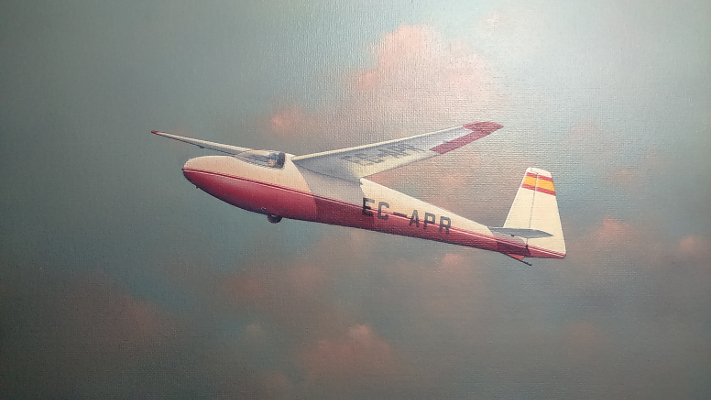

“Seven Stars” Viasa DC-10
Oil on canvas 60 x 42 cm.
Since it was founded in 1960 Until the Conclusion of Its activity in 1997, VIASA ( Venezolana Internacional de Aviacion SA ) was one of the Most Important aviation companies in South America. The aircraft Belonging to Seven Stars’ Line Were present in the main airports all over the world showing Their pretty typical orange-red livery, blue and white. With different classic VIASA jets worked : such as the Douglas DC-8, the Convair CV-880 or the Boeing 727. As far as spectacular McDonnell Douglas DC-10 is concerned, there was a nine-airplane fleet DC-10-30 variant so We Have Chosen to depict the aircraft With the license plate YV-138C (c / n 46557-197)
We Have Decided to work from a classic perspective in order to show all details of the airplane and the painting scheme: it is a profile but it Nearly can be seen from above for the big wings not to disturb. The engine on the right is hidden under the fuselage so the drawing is stylized. The nacelle of the left engine is leveled with a section of the fuselage poorly colored or detailed so there is a visual compensation. Our DC-10 Among the cumulus is reaching ITS cruise ceiling so are forming condensation trails. The tops of the clouds in the background Have Been profiled With some subtle touches while the thin ones in close-up show pasted and loose paint strokes. The labeling of These commercial aircraft, Along With the strips or the emblems are complicated and must be done in order not very Precisely damage to the corporative identity of the airlines. To Enrique Navarro, former pilot of VIASA and commander of the YV-138C.
Slingsby T-45 Swallow,
Oil on canvas 40 x 27 cm.
A British origin For This Swallow, one of the big classics in gliding. Also it is the sailplane Along With the Blanik, Which was flown in a larger number of units in Spain, Where These T-45 are still Known as “pepsicolos” (Pepsi Coke ones) due to Their much color scheme particularly painting. This one is an AGZ (c / n 1614) ready to land. We Have not featured as a place in particular, We Have Merely evocated to the same event That Happened in an airfield in Mora de Toledo.

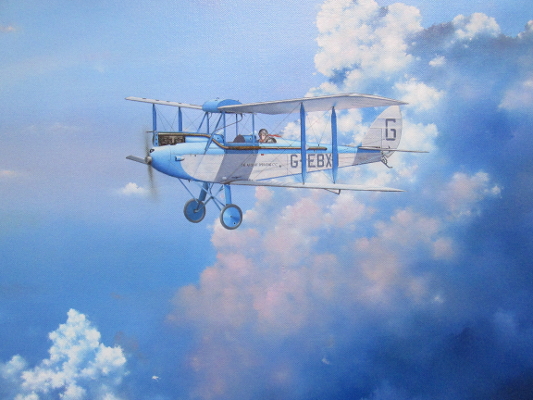
Fio blue (Fio’s Blue) / DH.60X Moth
Oil on canvas 55 x 44 cm.
Since I Decided to make a work, Which I wanted to offer to Fundación Infante de Orleans (Orleans’ Infant Foundation), i had no choice but DH.60 This outstanding collection From their own. I have always Been fond of the aircraft designed by the company De Havilland, so I Have Been to work collecting information on a series of paintings devoted to the Spanish Moths: DH.82, DH.87, and so on. The DH.60X (c / n 627) G-EBXU was built in 1928 and, at the time, it was some Equipped with floats, this is one of the many DH.60 still flying all over the world. The FIO’s one still has the painting scheme of Its very first owner, the Aircraft Operating Co., a small British company operated Between 1925 and That 1940 and was devoted to air Which photography works. Anyway, in Both the fuselage and under the tail-planes Also there is the Spanish license plate,
There are photographs of airplanes Thousands but I do not use them anymore but as a direct reference to select a color Merely range, These Are Also useful to focus on Certain details for the previous drawing on the canvas to be required as much as possible. I do not like the availability of pictures to be a condition to start working; I much prefer a model posing for a painting so I chose to model Usually in scale. This time I bought a kit from Amodel in 1/72 scale; I Carried out a basic assembly and Took a few photographs using different angles.
As far as color is concerned, I Thought About Exclusively blue shades for painting This work to be homogeneous and for a monochrome Nearly effect. In the upper part of the background and the shadow, just on the right, I applied mainly Outremer blue, turning to violet in some parts in the lower part Whilst onto the aircraft details and Prussian blue has-been used. I’d like to point out When working on That These calm and simple “aircraft portraits” Also I focus on pilots With Their Heads turning to right or left and staring at the viewers.
Havilland DH.82 “Herge”
Oil on canvas, 31 x 23 cm.
A friend of mine, Fernando F. Lerma, Suggested The Idea of this painting. Fernando is a painter and a modeller and owns an exquisite Also collection of miniatures and items related to the character Tintin ; some are unique pieces have built himself. We were Both curious to see the well-known Herge’s neat line turned into a “naturalist” work so we chose the outstanding yellow Tiger Moth from The Black Island flown by Thomson and Thompson , a really eventful flight , Although our painting does not really feature to particularly part of the book.
Often Aircraft Appear in the Adventures of Tintin . With Herge drew them all further details based, almost ever, in actual models identifiable easily. We really know DH.82A Existed That a license plate with a G-AIRJ, serial number 84326, Whose term of action would end in the British Record in 1952.

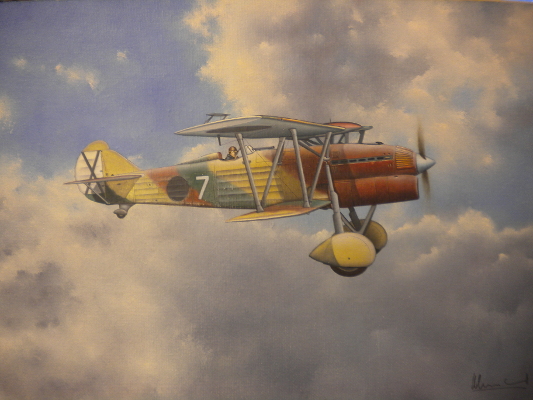
Fiat CR.32
Oil on canvas – 34 x 24 cm.
It is really a preparatory study for a bigger painting with Italian Fiat fighters in formation CR.32 During Spanish Civil War. This time, I used one of the scarce quality photographs of ” Chirri ” in the air and, for the ultimate picture, a very rare and expensive model in scale, Which was difficult to assemble as the quality was so really, really poor.
The CR.32 is a biplane, so it is difficult to depict, especially Because of the many struts of the wings and the landing gear. Depending on the perspective, they tend to create a They complicated framework, Which causes a strange drawing effect, and spoil the lines of the fuselage. On the other side, the upper plane is too low With regard to the hood and conceals a great part of the airplane When the angle is too tough.
JUN Mitsubishi J2M3 Raiden
Oil on canvas, 46 x 33 cm.
Thanks to my friend Luis Amarillas, I Have Been able to recover this Picture of a composition made very simply During my “sketching” period. I tried to work on This plane using a loose paint stroke. I have a true interest in Japanese design of fighters During WWII, so before carrying out this painting, i had done some color profiles of Both A5M Mitsubishi and Kawasaki Ki-61.
Also this is one of the first examples of a model in scale used as a reference, as there are very few photographs of esta fighter in the air and, all of them really are so well known. The almost profile of esta Raiden is stunning Because the unusual wide fuselage and relatively short wings are hidden. Also I wanted this painting to be delicate (Jun) and neat like old Japanese paintings so the effects in the background are subtle and softly done.
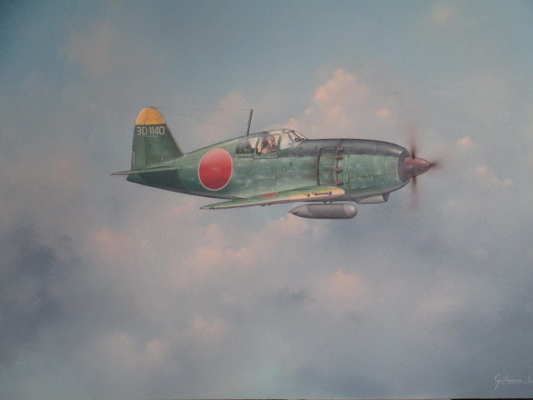
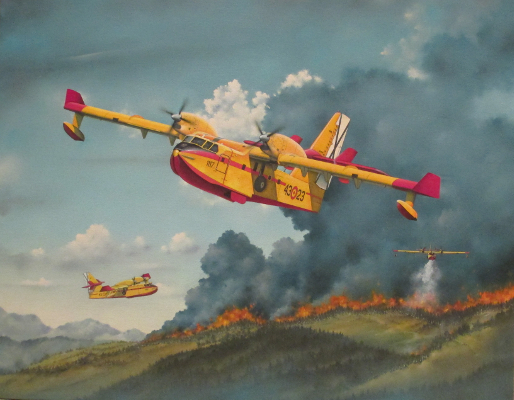
Professionals (Professionals) Canadair CL-215T
Oil on canvas, 81 x 65 cm.
Among all missions the Air Force was Entrusted, maybe the forest fire-fighting Carried out by the 43 rd Group was far too risky and spectacular, very well-known and very much appreciated. On the other hand, the Canadair is a colorful airplane and the only seaplane, Which is still in service in the Air Force. The CL-215T variant is the modern one With its multi-engine turboprop, big double blades in the tail plans and some winglets in the wings.
To this very day this is the biggest painting I have made aviation. Its 25F-format was a boundary, so I was forced to forget my very first thought (painting an aircraft just unloading the water). The force of the gravity, the wind and the speed create interesting effects in plastic liquid mass esta esta but HAD to be done using a non-landscape format along with a much simpler background. At the end, I chose to didactical composition, very usual in aviation paintwork and in the scale models’ box-art, the same airplane During a mission, but showing different views.
Special Pitts S-2nd
Oil on canvas, 46 x 46 cm.
This biplane is one of the great classic ones used for aerobatic flight all over the world That has-been on the forefront for Decades due to an excellent 1944-design by American Curtis Pitts. The two-seat EC-DHU (c / n 2181) was registered in Spain in 1979 and belongs to Fundacion Infante nowadays Orleans (FIO Orleans’ Infant Foundation); During the monthly exhibitions Usually it shows acrobatic ITS outstanding acting skills.
Undoubtedly, a great incentive is S-2A colorful painting schemes; the FIO’s one shows one of the MOST characteristic, entirely red and white with triangular bands in the wings and the tail plans. I wanted to just simply unreal Nearly background red colored to match the aircraft. There is a small and ridge of clouds Suggested Merely wising cross the axis of the fuselage and the wings. From the point of view Chosen it is possible to appreciate all Important details. I have used a square format Also, so unusual in aviation painting.
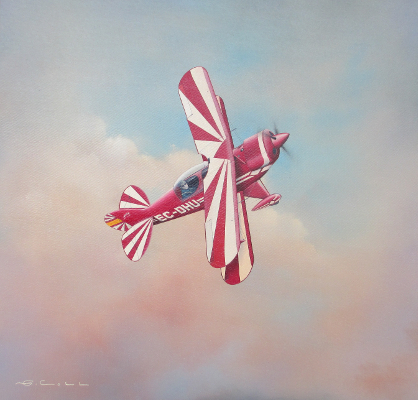

González Gil-Pazó GP-1
Oil on canvas, 41 x 31 cm.
The GP-1, was designed by the engineers Arturo Gonzalez Montes Gil and Jose Pazo, and won a competition organized in 1935 by the Military Aviation light aircraft for training. This promising career was frustrated by the beginning of the Spanish Civil War. The GP-1 Were Flown by the war Both parties During Entrusted mainly liaison missions. Later, in private hands, some of These Were Flown by different flying clubs Until the 1950s decade.
Although the painting is simple really, drawing This Light aircraft with stylish features was not so easy; I Did not want to copy any of the photographs i had found. There are very few pictures of esta airplane in the air and all of These are really well-known. The painting shows one of the prototypes, Which Flew With no license plate nor any citizenship emblem. Finding the right color of aircraft was esta Also a complicated task as there are no true references: greenish blue, greyish blue or green with some decoration in gray or aluminum color. In any case, the historical photographs Showed some dark shade.
Airbus A330-300
Pencil on paper, 39 x 22 cm.
Sometimes, I prefer not to start working right on the canvas but to make a detailed drawing as much as possible and subsequently transfer it to the canvas using graph paper or enlarged photocopies That I Employing trace using graphite powder. Usually I use pencils, but Depending on the kind of paper, ballpoint pens or thin Also felt-tip pens. In any case, all the elements of the airplane Important must be solved ACCORDING TO The Chosen perspective and the painting scheme, much better than a canvas plenty of lines, blotches and regretted paint strokes.
A much detail Important: the windows Whose number and disposition vary Depending on the variants (for A330-200 and A330-300 variants instance) or the decisions taken by the airline and the needs, as the measurements and the location of stripes, labels and logos in the fuselage, are ACCORDING tO windows and gates; as far as color is concerned, all These are the main striking details part of the paintwork.

All the images are copyright (c) 2018 by Guillermo Coll. All right reserved. Copy and distribution are forbidden
